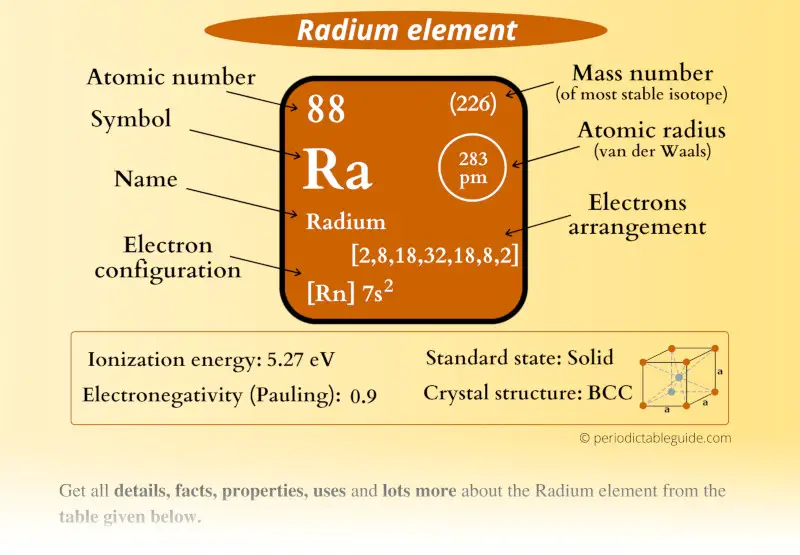
This is a SUPER easy guide on Radium element.
In fact, the table mentioned below is the perfect information box (Which gives you every single detail about the Radium element in Periodic table.)
So if you want to know anything about Radium element, then this guide is for you.
Let’s dive right into it!
Radium Element (Ra) Information
| Appearance |  Silvery-white metallic appearance |
| State (at STP) | Solid |
| Position in Periodic table | 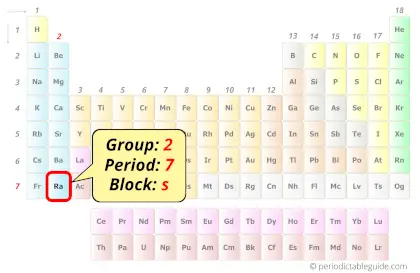 Group: 2, Period: 7, Block: s |
| Category | 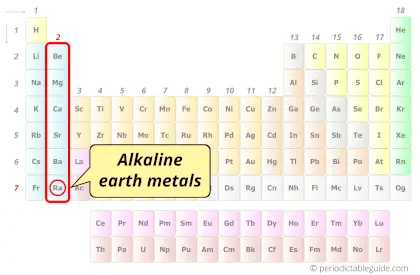 Alkaline earth metals |
| Atomic number or Protons | 88 |
| Neutrons | 138 |
| Electrons | 88 |
| Symbol | Ra |
| Atomic mass (most stable isotope) | 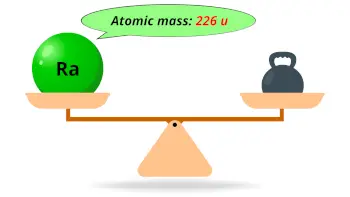 226 u |
| Electrons arrangement or Bohr model | 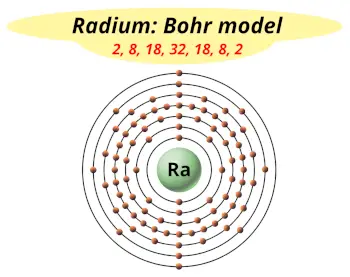 2, 8, 18, 32, 18, 8, 2 |
| Electronic configuration | [Rn] 7s2 |
| Atomic radius | 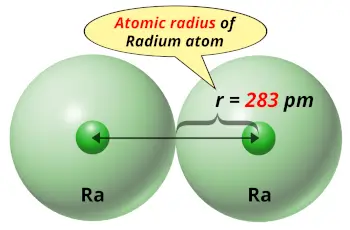 238 picometers (van der Waals radius) |
| Valence electrons | 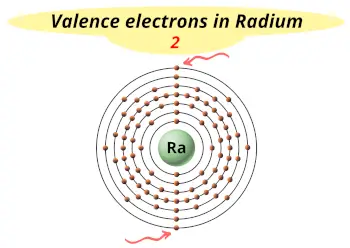 2 |
| 1st Ionization energy | 5.27 eV |
| Electronegativity | 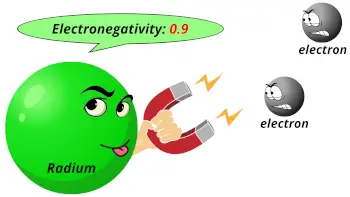 0.9 (Pauling scale) |
| Crystal structure | 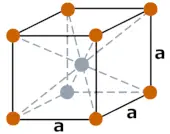 BCC (body centered cubic) |
| Melting point | 973 K or 700 °C or 1292 °F |
| Boiling point | 2010 K or 1737 °C or 3159 °F |
| Density | 5 g/cm3 |
| Main isotope | 226Ra |
| Who discovered Radium and when? | 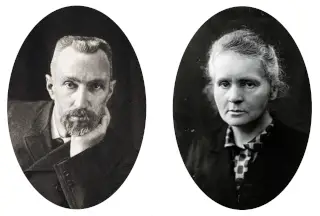 Pierre Curie and Marie Curie (in 1898) |
| CAS number | 7440-14-4 |
Radium in Periodic table
Radium element is in group 2 and period 7 of the Periodic table. Radium is the s-block element and it belongs to alkaline earth metals group.
| H | He | ||||||||||||||||
| Li | Be | B | C | N | O | F | Ne | ||||||||||
| Na | Mg | Al | Si | P | S | Cl | Ar | ||||||||||
| K | Ca | Sc | Ti | V | Cr | Mn | Fe | Co | Ni | Cu | Zn | Ga | Ge | As | Se | Br | Kr |
| Rb | Sr | Y | Zr | Nb | Mo | Tc | Ru | Rh | Pd | Ag | Cd | In | Sn | Sb | Te | I | Xe |
| Cs | Ba | La* | Hf | Ta | W | Re | Os | Ir | Pt | Au | Hg | Tl | Pb | Bi | Po | At | Rn |
| Fr | Ra | Ac** | Rf | Db | Sg | Bh | Hs | Mt | Ds | Rg | Cn | Nh | Fl | Mc | Lv | Ts | Og |
| *Ce | Pr | Nd | Pm | Sm | Eu | Gd | Tb | Dy | Ho | Er | Tm | Yb | Lu | ||||
| **Th | Pa | U | Np | Pu | Am | Cm | Bk | Cf | Es | Fm | Md | No | Lr |
←Move to: Francium (Fr) element – Periodic Table
→Move to: Actinium (Ac) element – Periodic Table
Why is Radium in Group 2?
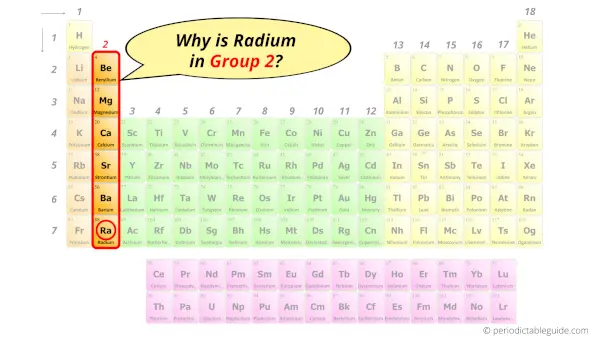
Do you know, how many electrons can be accommodated in the first shell, second shell, third shell, fourth shell, etc…?
Here is the table showing the capacity of orbits to hold electrons.
Number of electrons in shells.
| Orbit / Shell (n) | Maximum no. of electrons this orbit can hold (2 × n2) |
| K shell, n = 1 | 2 × 1² = 2 |
| L shell, n = 2 | 2 × 2² = 8 |
| M shell, n = 3 | 2 × 3² = 18 |
| N shell, n = 4 | 2 × 4² = 32 |
| . . . | . . . |
Thus,
- 1st shell can hold 2 electrons.
- 2nd shell can hold 8 electrons.
- 3rd shell can hold 18 electrons.
- 4th shell can hold 32 electrons, and so on…
Now the atomic number of Radium (Ra) is 88.
Hence the radium element has electrons arrangement 2, 8, 18, 32, 18, 8, 2.
This electron arrangement indicates that the outermost orbit of radium element (Ra) has 2 electrons.
Hence, it lies in group 2.
Why is Radium in Period 7?
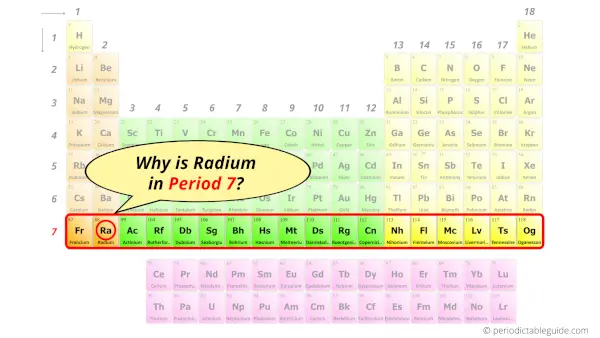
Let me ask you a question.
How many shells does radium have?
It’s 7. Right?
You have already seen the bohr model of radium atom in the above table.
From the Bohr model, it can be found that the number of orbits or shells in radium is 7. Hence, as radium has 7 orbits, it lies in period 7 of the Periodic table.
Why is Radium in s-block?
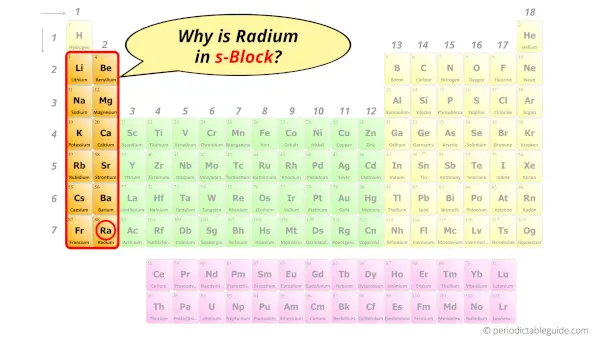
Before knowing this reason, first of all I want to ask you a simple question.
How can you determine the blocks-wise position of elements?
The simple answer: The elements will lie in the s, p, d or f block will completely depend upon the subshell in which the last electron will enter.
For example; the electron configuration of radium is [Rn] 7s2.
So the last electron of radium enters the s-subshell or s-orbital.
Hence, radium is the s-block element.
5 Interesting facts about Radium
Interesting facts about radium element are mentioned below.
- The name “Radium” was derived from the Latin word “radius”, which means “ray”.
- Radium element was discovered by Pierre Curie and Marie Curie in 1898.
- The concentration of radium in the earth’s crust is approximately 1 part per trillion by weight.
- The radium is present in uranium ore (mainly pitchblende) and it is generally obtained from radioactive decay of uranium.
- Out of all other alkaline earth metals on the periodic table, radium is the heaviest element.
Properties of Radium
The physical and chemical properties of radium element are mentioned below.
Physical properties of Radium
Physical properties of radium are mentioned below.
- Radium is a solid metal having a silvery white appearance.
- There are many isotopes of radium, and all these isotopes are radioactive in nature. The most abundant isotope is 226Ra, which has a half-life of around 1600 years.
- The atomic mass of most stable isotope of radium is 226 u and its density is 5 g/cm3.
- The crystal structure of radium is BCC (i.e body centered cubic).
- The melting point of radium is 700 °C and its boiling point is 1737 °C.
Chemical properties of Radium
Chemical properties of radium are mentioned below.
- When radium is kept open in the air, it reacts with nitrogen and its surface becomes dark due to the radium nitride layer formed on it.
- Just like other alkaline earth metals, radium reacts with water to form radium hydroxide and during this reaction it liberates hydrogen gas.
- Radium reacts with hydrochloric acid to give radium chloride.
Uses of Radium
Radium bromide (which is a compound of radium), was used in paints that glow. Such paints were used in devices like wrist watches, clocks, etc so that it can glow in the dark. But nowadays, radium has no commercial uses because of its radioactive nature.
Explore our New Interactive Periodic Table (with Rotating Bohr Models and More)

Details about this Periodic table:
- Access detailed info on all elements: atomic mass, electron configurations, charges, and more.
- View rotating Bohr models for all 118 elements.
- Get a free HD image of the Periodic Table.
Note: For future use, bookmark this Periodic table or visit “PeriodicTableGuide.com”
External resources:
- Radium – Element information, properties and uses | Periodic Table. (n.d.). Radium – Element Information, Properties and Uses | Periodic Table. https://www.rsc.org/periodic-table/element/88/radium
- Radium – Wikipedia. (2016, July 5). Radium – Wikipedia. https://en.wikipedia.org/wiki/Radium
- It’s Elemental – The Element Radium. (n.d.). It’s Elemental – the Element Radium. https://education.jlab.org/itselemental/ele088.html
- P. (n.d.). Radium. Radium | Ra – PubChem. https://pubchem.ncbi.nlm.nih.gov/compound/6328144
- Radium. (n.d.). NRC Web. https://www.nrc.gov/materials/radium.html
- The History of Radium. (n.d.). The History of Radium. http://large.stanford.edu/courses/2021/ph241/lui2/
